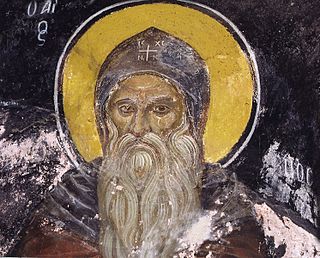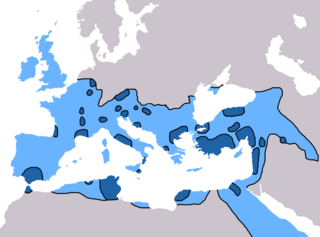Related Research Articles

Anthony the Great was a Christian monk from Egypt, revered since his death as a saint. He is distinguished from other saints named Anthony, such as Anthony of Padua, by various epithets: Anthony of Egypt, Anthony the Abbot, Anthony of the Desert, Anthony the Anchorite, Anthony the Hermit, and Anthony of Thebes. For his importance among the Desert Fathers and to all later Christian monasticism, he is also known as the Father of All Monks. His feast day is celebrated on 17 January among the Eastern Orthodox and Catholic churches and on Tobi 22 in the Coptic calendar.
Monasticism, also called monachism or monkhood, is a religious way of life in which one renounces worldly pursuits to devote oneself fully to spiritual work. Monastic life plays an important role in many Christian churches, especially in the Catholic, Orthodox and Anglican traditions as well as in other faiths such as Buddhism, Hinduism, and Jainism. In other religions, monasticism is criticized and not practiced, as in Islam and Zoroastrianism, or plays a marginal role, as in modern Judaism.

Pachomius, also known as Saint Pachomius the Great, is generally recognized as the founder of Christian cenobitic monasticism. Coptic churches celebrate his feast day on 9 May, and Eastern Orthodox and Roman Catholic churches mark his feast on 15 May or 28 May. In the Lutheran Church, he is remembered as a renewer of the church, along with his contemporary, Anthony of Egypt on 17 January.

A monastery is a building or complex of buildings comprising the domestic quarters and workplaces of monastics, monks or nuns, whether living in communities or alone (hermits). A monastery generally includes a place reserved for prayer which may be a chapel, church, or temple, and may also serve as an oratory, or in the case of communities anything from a single building housing only one senior and two or three junior monks or nuns, to vast complexes and estates housing tens or hundreds. A monastery complex typically comprises a number of buildings which include a church, dormitory, cloister, refectory, library, balneary and infirmary, and outlying granges. Depending on the location, the monastic order and the occupation of its inhabitants, the complex may also include a wide range of buildings that facilitate self-sufficiency and service to the community. These may include a hospice, a school, and a range of agricultural and manufacturing buildings such as a barn, a forge, or a brewery.

Christian monasticism is the devotional practice of Christians who live ascetic and typically cloistered lives that are dedicated to Christian worship. It began to develop early in the history of the Christian Church, modeled upon scriptural examples and ideals, including those in the Old Testament. It has come to be regulated by religious rules and, in modern times, the Canon law of the respective Christian denominations that have forms of monastic living. Those living the monastic life are known by the generic terms monks (men) and nuns (women). The word monk originated from the Greek μοναχός, itself from μόνος meaning 'alone'.

Hilarion the Great (291–371) was an anchorite who spent most of his life in the desert according to the example of Anthony the Great (c. 251–356). While Anthony is considered to have established Christian monasticism in the Egyptian Desert, Hilarion is considered by some to be the founder of Palestinian monasticism and venerated as a saint by the Orthodox and the Roman Catholic Church.

Cenobiticmonasticism is a monastic tradition that stresses community life. Often in the West the community belongs to a religious order, and the life of the cenobitic monk is regulated by a religious rule, a collection of precepts. The older style of monasticism, to live as a hermit, is called eremitic. A third form of monasticism, found primarily in Eastern Christianity, is the skete.

Mar Awgin or Awgen, also known as Awgin of Clysma or Saint Eugenios, was an Egyptian monk who, according to traditional accounts, introduced Christian monasticism to Syriac Christianity. These accounts, however, are all of late origin and often contain anachronisms. The historicity of Awgin is not certain.

John Cassian, also known as John the Ascetic and John Cassian the Roman, was a Christian monk and theologian celebrated in both the Western and Eastern churches for his mystical writings. Cassian is noted for his role in bringing the ideas and practices of early Christian monasticism to the medieval West.

The Desert Fathers were early Christian hermits and ascetics, who lived primarily in the Scetes desert of the Roman province of Egypt, beginning around the third century AD. The Apophthegmata Patrum is a collection of the wisdom of some of the early desert monks and nuns, in print as Sayings of the Desert Fathers. The first Desert Father was Paul of Thebes, and the most well known was Anthony the Great, who moved to the desert in AD 270–271 and became known as both the father and founder of desert monasticism. By the time Anthony had died in AD 356, thousands of monks and nuns had been drawn to living in the desert following Anthony's example, leading his biographer, Athanasius of Alexandria, to write that "the desert had become a city." The Desert Fathers had a major influence on the development of Christianity.
In Christianity, an oblate is a person who is specifically dedicated to God and to God's service.

Shenoute of Atripe, also known as Shenoute the Great or Saint Shenoute the Archimandrite was the abbot of the White Monastery in Egypt. He is considered a saint by the Oriental Orthodox Churches and is one of the most renowned saints of the Coptic Orthodox Church.

A skete is a monastic community in Eastern Christianity that allows relative isolation for monks, but also allows for communal services and the safety of shared resources and protection. It is one of four types of early monastic orders, along with the eremitic, lavritic and coenobitic, that became popular during the early formation of the Christian Church.

Pambo was a Coptic Desert Father of the fourth century and disciple of Anthony the Great. His feast day is July 18 among the Oriental Orthodox, Eastern Orthodox, and Catholic churches.

Eastern Christian monasticism is the life followed by monks and nuns of the Eastern Orthodox Church, Oriental Orthodoxy, the Church of the East and Eastern Catholicism. Eastern monasticism is founded on the Rule of St Basil and is sometimes thus referred to as Basilian.

Coptic monasticism was a movement in the Coptic Orthodox Church to create a holy, separate class of person from layman Christians.
Monasticism is a way of life where a person lives outside of society, under religious vows.

In 6th-century Christianity, Roman Emperor Justinian launched a military campaign in Constantinople to reclaim the western provinces from the Germans, starting with North Africa and proceeding to Italy. Though he was temporarily successful in recapturing much of the western Mediterranean he destroyed the urban centers and permanently ruined the economies in much of the West. Rome and other cities were abandoned. In the coming centuries the Western Church, as virtually the only surviving Roman institution in the West, became the only remaining link to Greek culture and civilization.

Chariton the Confessor was an early Christian monk. He is venerated as a saint by both the Western and Eastern Churches. His remembrance day is September 28.
Mount Colzim, also known as the Inner Mountain of Saint Anthony, is a mountain in Red Sea Governorate, Egypt. It was the final residency of Anthony the Great from about AD 311, when he was 62 years of age, to his death in 356.
References
- ↑ Merriam-Webster: idiorrhythmic.
- ↑ "Idiorrhythmic monasticism".
- ↑ "Idiorrhythmic Monasticism", The Oxford Dictionary of Byzantium (Oxford University Press, 1991).

